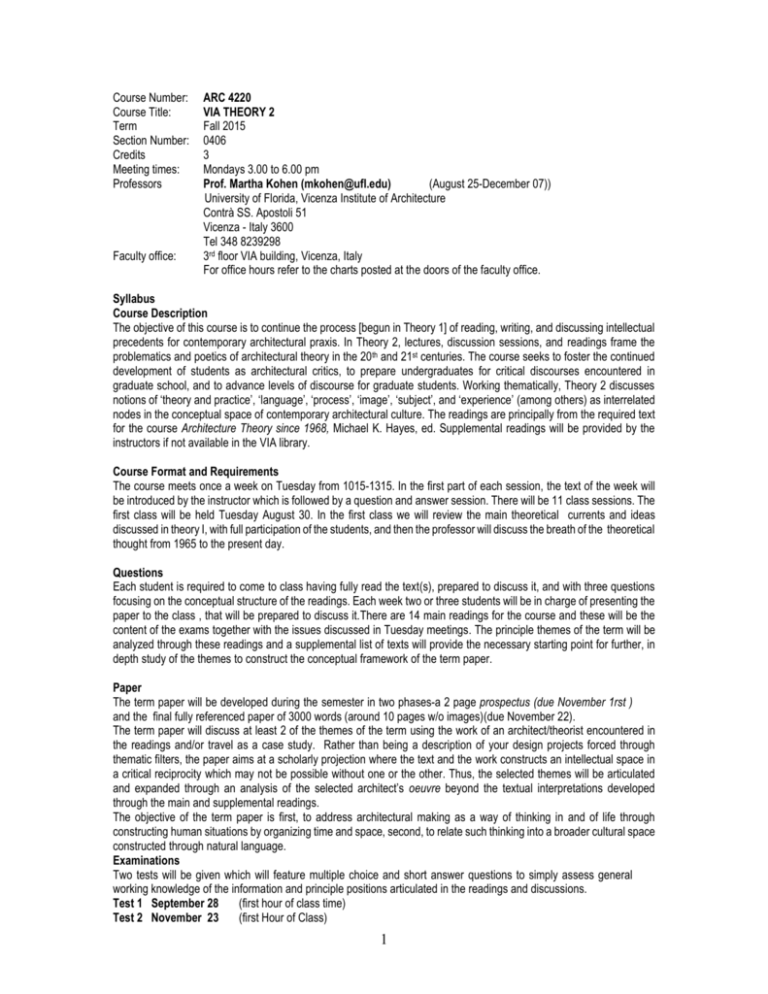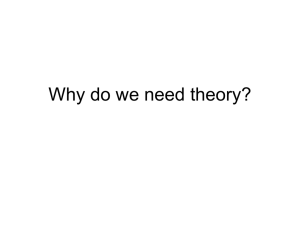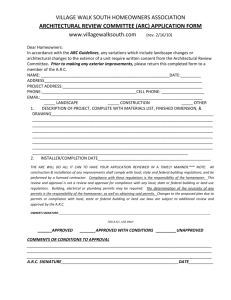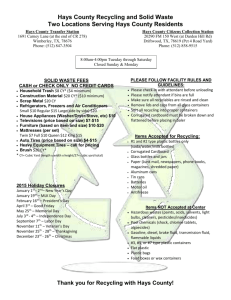ARC 4220 Architectural Theory 2
advertisement

Course Number: Course Title: Term Section Number: Credits Meeting times: Professors Faculty office: ARC 4220 VIA THEORY 2 Fall 2015 0406 3 Mondays 3.00 to 6.00 pm Prof. Martha Kohen (mkohen@ufl.edu) (August 25-December 07)) University of Florida, Vicenza Institute of Architecture Contrà SS. Apostoli 51 Vicenza - Italy 3600 Tel 348 8239298 3rd floor VIA building, Vicenza, Italy For office hours refer to the charts posted at the doors of the faculty office. Syllabus Course Description The objective of this course is to continue the process [begun in Theory 1] of reading, writing, and discussing intellectual precedents for contemporary architectural praxis. In Theory 2, lectures, discussion sessions, and readings frame the problematics and poetics of architectural theory in the 20th and 21st centuries. The course seeks to foster the continued development of students as architectural critics, to prepare undergraduates for critical discourses encountered in graduate school, and to advance levels of discourse for graduate students. Working thematically, Theory 2 discusses notions of ‘theory and practice’, ‘language’, ‘process’, ‘image’, ‘subject’, and ‘experience’ (among others) as interrelated nodes in the conceptual space of contemporary architectural culture. The readings are principally from the required text for the course Architecture Theory since 1968, Michael K. Hayes, ed. Supplemental readings will be provided by the instructors if not available in the VIA library. Course Format and Requirements The course meets once a week on Tuesday from 1015-1315. In the first part of each session, the text of the week will be introduced by the instructor which is followed by a question and answer session. There will be 11 class sessions. The first class will be held Tuesday August 30. In the first class we will review the main theoretical currents and ideas discussed in theory I, with full participation of the students, and then the professor will discuss the breath of the theoretical thought from 1965 to the present day. Questions Each student is required to come to class having fully read the text(s), prepared to discuss it, and with three questions focusing on the conceptual structure of the readings. Each week two or three students will be in charge of presenting the paper to the class , that will be prepared to discuss it.There are 14 main readings for the course and these will be the content of the exams together with the issues discussed in Tuesday meetings. The principle themes of the term will be analyzed through these readings and a supplemental list of texts will provide the necessary starting point for further, in depth study of the themes to construct the conceptual framework of the term paper. Paper The term paper will be developed during the semester in two phases-a 2 page prospectus (due November 1rst ) and the final fully referenced paper of 3000 words (around 10 pages w/o images)(due November 22). The term paper will discuss at least 2 of the themes of the term using the work of an architect/theorist encountered in the readings and/or travel as a case study. Rather than being a description of your design projects forced through thematic filters, the paper aims at a scholarly projection where the text and the work constructs an intellectual space in a critical reciprocity which may not be possible without one or the other. Thus, the selected themes will be articulated and expanded through an analysis of the selected architect’s oeuvre beyond the textual interpretations developed through the main and supplemental readings. The objective of the term paper is first, to address architectural making as a way of thinking in and of life through constructing human situations by organizing time and space, second, to relate such thinking into a broader cultural space constructed through natural language. Examinations Two tests will be given which will feature multiple choice and short answer questions to simply assess general working knowledge of the information and principle positions articulated in the readings and discussions. Test 1 September 28 (first hour of class time) Test 2 November 23 (first Hour of Class) 1 Schedule and Main Readings (Consult main VIA semester schedule for key dates on other courses and trips). 8.31.2015 Revision of Theory I Hays, M. K. 1998. Architecture Theory Since 1968. Cambridge and London: The MIT Press. [Introduction] Nesbitt, K. 1996. Theorizing a New Agenda for Architecture: An Anthology of Architectural Theory 1965-1995. New York: Princeton Architectural Press. [Introduction- Handout] 9.07.15 Tafuri, M. 1969. In Architecture Theory Since 1968, ed. K. M. Hays, 2-35. 9.14.15 Tschumi, B. 1975. The Architectural Paradox. In Architecture Theory Since 1968, ed. K. M. Hays, 214-229. 9.21.15 Frampton, K. 1979. The Status of Man and the Status of His Objects: A Reading of the Human Condition. . In Architecture Theory Since 1968, ed. K. M. Hays, 358-377. 09.28.15 Test 1 Rowe, C. 1972. Introduction to Five Architects. In Architecture Theory Since 1968, ed. K. M. Hays, 72-85. Recommended reading: Culot, M., Krier, L., The Only Path for Architecture. In Architecture Theory Since 1968, ed. K. M. Hays, 348-355. Teyssot, G. 1977. Heterotopias and the History of Spaces, In Architecture Theory Since 1968, ed. K. M. Hays, 296-305. 10.25.11 Paper Prospectus Due Pérez-Gómez, A. Introduction to Architecture and the Crisis of Modern Science. . In Architecture Theory Since 1968, ed. K. M. Hays, 744-757. 11.01.11 Koolhaas,R. 1977. Life in the Metropolis, or the Culture of Congestion. In Architecture Theory Since 1968, ed. K. M. Hays, 320-330. Vidler, Anthony, 1992. From the Architectural Uncanny: Essays in the Modern Unhomely. In Architecture Theory Since 1968, ed. K. M. Hays, 744-757. 11.08.11 Solà-Morales, I. 1996. Weak Architecture. In Architecture Theory Since 1968, ed. K. M. Hays, 614-623. 11.15.11 Derrida, J. 1986b. Point de Folie – Maintenant l’architecture. In Architecture Theory Since 1968, ed. K. M. Hays, 566581. Cambridge and London: The MIT Press, 1998. 11.22.11 Paper final submission Liebskind, D. Chamber Works. In Architecture Theory Since 1968, ed. K. M. Hays, 480-489. Evans, R. 1984. In Front of Lines that Leave Nothing Behind. In Architecture Theory Since 1968, ed. K. M. Hays, 476479. 11.29.11 Test 2/ Final class discussion Required textbook: Architecture Theory since 1968, Michael K. Hayes, ed. Supplemental Readings to Support Research 2 [in VIA Library, available online, or as handouts from instructor] Arendt, H. 1958. The Human Condition. Chicago: The Chicago University Press. Bachelard, G. 1958. The Poetics of Space. Trans. M. Jolas. Boston: Beacon Press, 1994. Barthes, R. 1970. The Third Meaning. In Image, Music, Text. Trans. S. Heath, 44-68. New York: Noonday Press, 1977. Dewey, J. 1934. Art as Experience. New York: Minton, Balch and Company. Evans, R. 1995. The Projective Cast: Architecture and Its Three Geometries. London and Cambridge: The MIT Press. Frampton, K. 1990. Rappel a l’ordre, the Case for the Tectonic. In Theorizing a New Agenda for Architecture: An Anthology of Architectural Theory 1965-1995. ed. K. Nesbitt, 517-530. New York: Princeton Architectural Press, 1996. Frampton, K. 1995. Studies in Tectonic Culture: The Poetics of Construction in Nineteenth and Twentieth Century Architecture. ed. J. Cava. London and Cambridge: The MIT Press. Frascari, M. 1984. The Tell-the-Tale Detail. In Theorizing a New Agenda for Architecture: An Anthology of Architectural Theory 1965-1995. ed. K. Nesbitt, 499-515. New York: Princeton Architectural Press, 1996. Norberg-Schulz, C. 1965. Intentions in Architecture. Massachusetts: The MIT Press, 1988. Norberg-Schulz, C. 1974. Meaning in Western Architecture. New York: Prager Publishers, 1975. Norberg-Schulz, C. 1986. Architecture: Meaning and Place. New York: Electa/Rizzoli, 1988. Panofsky, E. 1951. Gothic Architecture and Scholasticism. Cleveland and New York: Meridian Books, 1967. Panofsky, E. 1955. Meaning in the Visual Arts New York: The Overlook Press, 1974. Perez-Gomez, A. 1983. Architecture and the Crisis of Modern Science. Cambridge and London: The MIT Press. Rossi, A. 1976. An Analogical Architecture. In Theorizing a New Agenda for Architecture: An Anthology of Architectural Theory 1965-1995. ed. K. Nesbitt, 346-353. New York: Princeton Architectural Press, 1996. Rowe, C. and Slutzky, R. 1971. Transparency: Literal and Phenomenal, Part II. Perspecta 13: 287-301. [both essays can be found on-line at www.jstor.org through UF library site ] Sola-Morales, I. 1995. Differences / Topographies of Contemporary Architecture, ed. Sarah Whiting. The MIT Press, 1997. Tafuri, M. 1976. Theories and History of Architecture. Trans. G. Verrecchia. New York: Harper and Row, 1980. Tschumi, B. 1981. The Manhattan Transcripts. London and New York: Academy Group, 1994. Wigley, M. 1988. The Translation of Architecture, the Production of Babel. In Architecture Theory Since 1968, ed. K. M. Hays, 658-675. Cambridge and London: The MIT Press, 1998. Worringer, W. 1908. Abstraction and Empathy. New York: International Universities Press, 1953. Attendance There is no possibility to make up a missed seminar session. A session with your professor may or may not be possible and cannot duplicate the collective conversation. As a result our policy on attendance is extremely strict: ANY absence must be explained; i.e. call into the office and have a note left for your professor or an email. It is your responsibility to get the assignments from your fellow students. Un-excused absences will adversely affect your grade and excessive absences can result in a failing grade. The number of absences adversely affecting your grade is at the discretion of the professor. Lateness is not permitted if not justified nor leaving early. If something is seriously wrong please do not hesitate to talk to your professor about it. Arrangements will be made to cope with serious illness, family or personal crises. Grading Class participation [Active involvement in discussion sessions, handing in written questions, and general attendance] 20 Test 1 20 Test 2 20 Paper-prospectus and final version 40 Grading Scale A Outstanding work only 3 AB+ B BC+ C CD+ D E Close to outstanding Very Good Work Good Work Good work with some problems Slightly Above Average Work Average Work Average Work with some problems Poor Work with some effort Poor Work Inadequate Work Regarding accommodations for students with disabilities "Students requesting classroom accommodation must first register with the Dean of Students Office. The Dean of Students Office will provide documentation to the student who must then provide this documentation to the Instructor when requesting accommodation. " 4 CV NAME OF FACULTY MEMBER Martha Kohen Courses Taught ( 2010-11, 2011-12) ARC 6911 Sustainable Urbanism Seminar ARC 3320 Architectural Design 5 ARC 6242 Research Methods ARC 3321 Architectural Design 6 ARC 6356 Advanced Graduate Design 3 ARC 4220 Architecture Theory 2 Educational Credentials Dipl Arch Cantab . (MA) University of Cambridge England 1972 Arquitecto .Universidad de la Republica.Uruguay Teaching Experience Profesor Grado 3 Facultad de Arquitectura UDELAR 1985-1996 Profesor Grado 4 Facultad de Arquitectura y Urbanismo UDELAR 1997-2002 Professor, University of Florida, 2003-present Professional Experience MKRO, principal , Montevideo Uruguay, 1987-2003 License/Registration Uruguay Selected publications Piano Progetto e Citta’ Cuaderno No.3 Pescara Italy Linda Kohen., On and About. 2010 Professional Memberships SAU, (Sociedad de Arquitectos del Uruguay) UUU(Union de Urbanistas del Uruguay) DOCOMOMO International and Docomomo Florida 5







